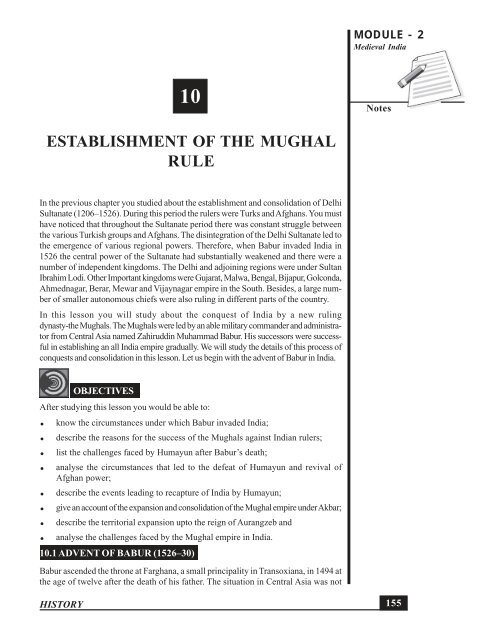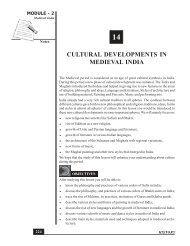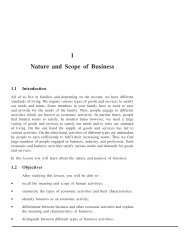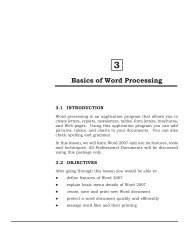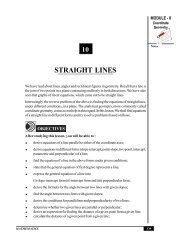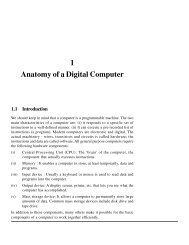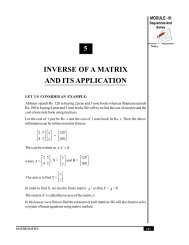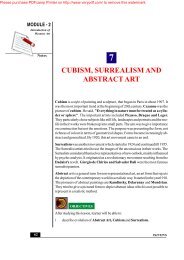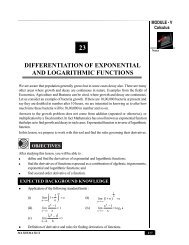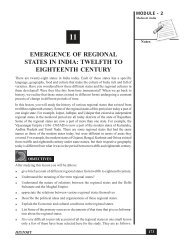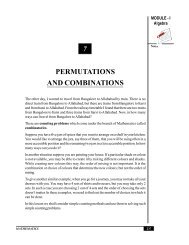You also want an ePaper? Increase the reach of your titles
YUMPU automatically turns print PDFs into web optimized ePapers that Google loves.
MODULE - 2Medieval India10NotesESTABLISHMENT OF THE MUGHALRULEIn <strong>the</strong> previous chapter you studied about <strong>the</strong> establishment and consolidation <strong>of</strong> DelhiSultanate (1206–1526). During this period <strong>the</strong> rulers were Turks and Afghans. You musthave noticed that throughout <strong>the</strong> Sultanate period <strong>the</strong>re was constant struggle between<strong>the</strong> various Turkish groups and Afghans. The disintegration <strong>of</strong> <strong>the</strong> Delhi Sultanate led to<strong>the</strong> emergence <strong>of</strong> various regional powers. Therefore, when Babur invaded India in1526 <strong>the</strong> central power <strong>of</strong> <strong>the</strong> Sultanate had substantially weakened and <strong>the</strong>re were anumber <strong>of</strong> independent kingdoms. The Delhi and adjoining regions were under SultanIbrahim Lodi. O<strong>the</strong>r Important kingdoms were Gujarat, Malwa, Bengal, Bijapur, Golconda,Ahmednagar, Berar, Mewar and Vijaynagar empire in <strong>the</strong> South. Besides, a large number<strong>of</strong> smaller autonomous chiefs were also ruling in different parts <strong>of</strong> <strong>the</strong> country.In this lesson you will study about <strong>the</strong> conquest <strong>of</strong> India by a new rulingdynasty-<strong>the</strong> <strong>Mughal</strong>s. The <strong>Mughal</strong>s were led by an able military commander and administratorfrom Central Asia named Zahiruddin Muhammad Babur. His successors were successfulin establishing an all India empire gradually. We will study <strong>the</strong> details <strong>of</strong> this process <strong>of</strong>conquests and consolidation in this lesson. Let us begin with <strong>the</strong> advent <strong>of</strong> Babur in India.OBJECTIVESAfter studying this lesson you would be able to:know <strong>the</strong> circumstances under which Babur invaded India;describe <strong>the</strong> reasons for <strong>the</strong> success <strong>of</strong> <strong>the</strong> <strong>Mughal</strong>s against Indian rulers;list <strong>the</strong> challenges faced by Humayun after Babur’s death;analyse <strong>the</strong> circumstances that led to <strong>the</strong> defeat <strong>of</strong> Humayun and revival <strong>of</strong>Afghan power;describe <strong>the</strong> events leading to recapture <strong>of</strong> India by Humayun;give an account <strong>of</strong> <strong>the</strong> expansion and consolidation <strong>of</strong> <strong>the</strong> <strong>Mughal</strong> empire under Akbar;describe <strong>the</strong> territorial expansion upto <strong>the</strong> reign <strong>of</strong> Aurangzeb andanalyse <strong>the</strong> challenges faced by <strong>the</strong> <strong>Mughal</strong> empire in India.10.1 ADVENT OF BABUR (1526–30)Babur ascended <strong>the</strong> throne at Farghana, a small principality in Transoxiana, in 1494 at<strong>the</strong> age <strong>of</strong> twelve after <strong>the</strong> death <strong>of</strong> his fa<strong>the</strong>r. The situation in Central Asia was notHISTORY 155
<strong>Establishment</strong> <strong>of</strong> <strong>the</strong> <strong>Mughal</strong> <strong>Rule</strong>muster support <strong>of</strong> a large number <strong>of</strong> Rajput chiefs. Prominent among <strong>the</strong>se wereJalor, Sirohi, Dungarpur, Amber, Merta etc. Medini Rai <strong>of</strong> Chanderi, Hasan Khan <strong>of</strong>Mewat and Mahmud Lodi younger son <strong>of</strong> Sikander Lodi also joined Rana with <strong>the</strong>irforces. Possibly, Rana Sanga expected Babur to return to Kabul. Babur’s decision tostay back must have given a big jolt to Rana Sanga’s ambitions. Babur was also fullyaware <strong>of</strong> <strong>the</strong> fact that it would be impossible for him to consolidate his position in Indiaunless he shattered Rana’s power. The forces <strong>of</strong> Babur and Rana Sanga met atKhanwa, a place near Fatehpur Sikri. Rana Sanga was defeated in 1527 and onceagain <strong>the</strong> superior military tactics <strong>of</strong> Babur succeeded. With <strong>the</strong> defeat <strong>of</strong> Rana <strong>the</strong>biggest challenge in north India was shattered.MODULE - 2Medieval IndiaNotesBheraSialkotLahorMap 10.1 Early conquests <strong>of</strong> <strong>the</strong> <strong>Mughal</strong>sThough <strong>the</strong> Mewar Rajputs received great shock at Khanwa, Medini Rai at Malwawas still threatening to challenge <strong>the</strong> authority <strong>of</strong> Babur. In spite <strong>of</strong> great valour withwhich <strong>the</strong> Rajputs fought in Chanderi (1528), Babur faced little difficulty in overcomingMedini Rai. With his defeat, resistance across Rajputana was completely shattered.But Babur had to tackle <strong>the</strong> Afghans. The Afghans had surrendered Delhi, butHISTORY157
MODULE - 2Medieval IndiaNotes<strong>Establishment</strong> <strong>of</strong> <strong>the</strong> <strong>Mughal</strong> <strong>Rule</strong><strong>the</strong>y were still powerful in <strong>the</strong> east (Bihar and parts <strong>of</strong> Jaunpur). The success against<strong>the</strong> Afghans and Rajputs at Panipat and Khanwa was very significant but <strong>the</strong> resistancewas still present. However, <strong>the</strong>se victories were a step forward in <strong>the</strong> direction<strong>of</strong> <strong>the</strong> establishment <strong>of</strong> <strong>Mughal</strong> empire. Babur died in 1530. Still <strong>the</strong> rulers <strong>of</strong> Gujarat,Malwa and Bengal enjoyed substantial military power and were not suppressed. Itwas left to Humayun to face <strong>the</strong>se regional powers.INTEXT QUESTIONS 10.11. Why did Babur invade India?2. What was Babur’s strategy at <strong>the</strong> Battle <strong>of</strong> Panipat?3. What problems did Babur face after <strong>the</strong> Battle <strong>of</strong> Panipat?4. Who were <strong>the</strong> two rulers from Rajputana defeated by Babur?2.2 HUMAYUN’S RETREAT AND AFGHAN REVIVAL (1530–1540)After <strong>the</strong> death <strong>of</strong> Babur in 1530, his son Humayun succeeded him. The situationunder Humayun was quite desperate. The main problems faced by Humayun were:i. The newly conquered territories and administration was not consolidated.ii. Unlike Babur, Humayun did not command <strong>the</strong> respect and esteem <strong>of</strong> <strong>Mughal</strong>nobility.iii. The Chaghatai nobles were not favourably inclined towards him and <strong>the</strong> Indian nobles,who had joined Babur’s service, deserted <strong>the</strong> <strong>Mughal</strong>s at Humayun’s accession.iv. He also confronted <strong>the</strong> hostility <strong>of</strong> <strong>the</strong> Afghans mainly Sher Khan in Bihar on <strong>the</strong>one hand and Bahadurshah, <strong>the</strong> ruler <strong>of</strong> Gujarat, on <strong>the</strong> o<strong>the</strong>r.v. As per <strong>the</strong> Timurid tradition Humayun had to share power with his bro<strong>the</strong>rs. Thenewly established <strong>Mughal</strong> empire had two centres <strong>of</strong> power – Humayun was incontrol <strong>of</strong> Delhi, Agra and Central India, while his bro<strong>the</strong>r Kamran had Afghanistanand Punjab under him.Humayun felt that <strong>the</strong> Afghans were a bigger threat. He wanted to avoid a combinedopposition <strong>of</strong> Afghans from east and <strong>the</strong> west. At that time Bahadur Shah had occupiedBhilsa, Raisen, Ujjain and Gagron and was consolidating his power. While Humayun wasbesieging Chunar in <strong>the</strong> east, Bahadur Shah had started expanding towards Malwa andRajputana. In such a situation Humayun was forced to rush back to Agra (1532–33).Continuing his expansionist policy, Bahadur Shah attacked Chittor in 1534. Chittor hadstrategic advantage as it could provide a strong base. It would have helped his expansionin Rajasthan particularly towards Ajmer, Nagor and Ranthambhor. Humayun capturedMandu and camped <strong>the</strong>re because he thought that from here he can block BahadurShah’s return to Gujarat. Humayun’s long absence from Agra resulted in rebellions inDoab and Agra and he had to rush back. Mandu was now left under <strong>the</strong> charge <strong>of</strong> MirzaAskari, <strong>the</strong> bro<strong>the</strong>r <strong>of</strong> Humayun. During <strong>the</strong> period when Humayun was busy in Gujaratto check Bahadurshah, Sher Shah started consolidating himself in Bihar and Bengal.158 HISTORY
<strong>Establishment</strong> <strong>of</strong> <strong>the</strong> <strong>Mughal</strong> <strong>Rule</strong>Rise <strong>of</strong> Sher Shah SuriFarid, who later came to be called Sher Khan and subsequently Sher Shah, was son <strong>of</strong> aJagirdar under <strong>the</strong> kingdom <strong>of</strong> Jaunpur. His fa<strong>the</strong>r Hasan Khan Sur held <strong>the</strong> jagir <strong>of</strong>Sasaram in Bihar during <strong>the</strong> rule <strong>of</strong> Lodis. Sher Shah helped his fa<strong>the</strong>r in <strong>the</strong> administration<strong>of</strong> his jagir. Later he developed differences with his fa<strong>the</strong>r and left him. He servedunder Afghan nobles. After <strong>the</strong> death <strong>of</strong> his fa<strong>the</strong>r in 1524 he was given his fa<strong>the</strong>r’s jagirby Ibrahim Lodi. He had to enter into conflict with his family to take possession <strong>of</strong> <strong>the</strong>jagir. He very effectively managed <strong>the</strong> Jagir <strong>of</strong> his fa<strong>the</strong>r. He also acquired great militaryand administrative skills. His capabilities made him <strong>the</strong> leader <strong>of</strong> Afghans. He graduallyincreased his influence and defeated Sultan Mahmud Shah <strong>of</strong> Bengal. He emergedas <strong>the</strong> most powerful military commander in <strong>the</strong> eastern provinces. Sher Shah continuedconsolidating his position in Bihar. He had to enter into a number <strong>of</strong> conflicts with prominentAfghan nobles in Bihar and ruler <strong>of</strong> Bengal. He finally succeeded in establishinghimself as <strong>the</strong> most powerful Afghan chief in Eastern India.MODULE - 2Medieval IndiaNotesSher Shah wished to establish himself as <strong>the</strong> undisputed Afghan leader. He invaded<strong>the</strong> Bengal army and defeated <strong>the</strong>m in <strong>the</strong> battle <strong>of</strong> Surajgarh. Sher Shah couldMap 10.2: Empire <strong>of</strong> Sher ShahHISTORY159
MODULE - 2Medieval IndiaNotes<strong>Establishment</strong> <strong>of</strong> <strong>the</strong> <strong>Mughal</strong> <strong>Rule</strong>extract quite a wealth from Bengal which helped him to raise a bigger army. Now hestarted attacking <strong>Mughal</strong> territories <strong>of</strong> Banaras and beyond. Humayun was quitesuspicious <strong>of</strong> Sher Shah’s ambitions but failed to estimate his capabilities. He askedhis governor <strong>of</strong> Jaunpur, Hindu Beg to check <strong>the</strong> movements <strong>of</strong> Sher Shah. MeanwhileSher Shah captured Gaur (1538) <strong>the</strong> capital <strong>of</strong> Bengal. While Humayun wasmoving towards Bengal Sher Shah took control <strong>of</strong> route to Agra making communicationdifficult for Humayun. On <strong>the</strong> o<strong>the</strong>r hand, Hindal Mirza, bro<strong>the</strong>r <strong>of</strong> Humayun,who was supposed to provide supplies for his army, declared his independence. Now,Humayun decided to return to Chunar. When he reached Chausa (1539), he encampedon <strong>the</strong> western side <strong>of</strong> <strong>the</strong> river Karmnasa. Sher Shah attacked Humayun at<strong>the</strong> bank <strong>of</strong> <strong>the</strong> river and defeated him. Sher Shah declared himself as an independentking. Humayun could escape but most <strong>of</strong> his army was destroyed. With difficulty hecould reach Agra. His bro<strong>the</strong>r Kamran moved out <strong>of</strong> Agra towards Lahore leavingHumayun with small force. Sher Shah now moved towards Agra. Humayun alsocame forward with his army and <strong>the</strong> armies <strong>of</strong> <strong>the</strong> two clashed at Kannauj. Humayunwas defeated badly in <strong>the</strong> battle <strong>of</strong> Kannauj (1540).10.3 SECOND AFGHAN EMPIRE (1540–1555)Sher ShahAs already discussed <strong>the</strong> first Afghan kingdom under <strong>the</strong> Lodis was replaced by <strong>the</strong><strong>Mughal</strong>s under Babur in 1526. After a gap <strong>of</strong> 14 years Sher Shah succeeded inestablishing <strong>the</strong> Afghan rule again in India in 1540. Sher Shah and his successorsruled for 15 years. This period is known as <strong>the</strong> period <strong>of</strong> second Afghan Empire.The founder <strong>of</strong> this Afghan rule Sher Khan was a great tactician and able militarycommander. We have already discussed his conflict with Humayun. After defeatingHumayun he became sovereign ruler in <strong>the</strong> year 1540 and assumed <strong>the</strong>title <strong>of</strong> Sher Shah.Sher Shah followed Humayun on his flight till Sindh in <strong>the</strong> North West. After expellingHumayun he started consolidating his position in Nor<strong>the</strong>rn and Eastern India. Hedefeated and conquered Malwa in 1542 which was followed by Chanderi. In Rajasthanhe led campaigns against Marwar, Ranthambhore, Nagor, Ajmer, Merta Jodhpur andBikaner. He defeated rebellious Afghans in Bengal. By 1545 he had established himselfas <strong>the</strong> supreme ruler from Sindh and Punjab to whole <strong>of</strong> Rajputana in <strong>the</strong> Westand Bengal in <strong>the</strong> East. Now he turned towards BundelKhand. Here while besieging<strong>the</strong> fort <strong>of</strong> Kalinjar he died in 1545 in an accidental blast <strong>of</strong> gun powder.During his brief rule Sher Shah introduced very important changes in administrationand revenue system. The most important ones were:i. X judicial system.Sher Shah was succeeded by his son Islam Shah. Islam Shah had to face a number <strong>of</strong>conflicts with his bro<strong>the</strong>r Adil Khan and many Afghan nobles. He died in 1553. TheAfghan empire was substantially weakened. Humayun saw an opportunity and movedtowards India. He again captured his lost kingdom by 1555 and ended <strong>the</strong> secondAfghan Empire.In 1555 Humayun conquered Agra and Delhi and established himself as <strong>the</strong> emperor<strong>of</strong> India. Before he could consolidate his position he died after falling from <strong>the</strong> stairs<strong>of</strong> <strong>the</strong> library at Sher Mandal (in Delhi) in 1556.160 HISTORY
<strong>Establishment</strong> <strong>of</strong> <strong>the</strong> <strong>Mughal</strong> <strong>Rule</strong>MODULE - 2Medieval IndiaINTEXT QUESTIONS 10.21. Why did Humayun fail to defeat Sher Shah?Notes2. How did Sher Khan emerge as <strong>the</strong> leader <strong>of</strong> Afghans?3. List <strong>the</strong> territories which were brought by Sher Shah under his rule.4. List two important achievements <strong>of</strong> Sher Shah.10.4 THE MUGHAL EMPIRE FROM AKBAR TO AURANGZEBAkbarAkbar was only thirteen years old at <strong>the</strong> time <strong>of</strong> Humayun’s death. When his fa<strong>the</strong>rdied, Akbar was at Kalanaur in Punjab and <strong>the</strong>refore his coronation took place in Kalanauritself in 1556. It was his tutor and Humayun’s favourite and confidant Bairam Khan,who served as <strong>the</strong> regent <strong>of</strong> <strong>the</strong> <strong>Mughal</strong> emperor from 1556 to 1560. He became <strong>the</strong>wakil <strong>of</strong> <strong>the</strong> kingdom with <strong>the</strong> title <strong>of</strong> Khan-i-Khanan. One <strong>of</strong> <strong>the</strong> major achievements<strong>of</strong> his regency period was <strong>the</strong> defeat <strong>of</strong> Hemu and <strong>the</strong> Afghan forces in <strong>the</strong> secondbattle <strong>of</strong> Panipat in 1556, who were posing a serious threat to <strong>the</strong> <strong>Mughal</strong> Empire.Regency <strong>of</strong> Bairam Khan 1556–1560Bairam Khan remained at <strong>the</strong> helm <strong>of</strong> affairs <strong>of</strong> <strong>the</strong> <strong>Mughal</strong> Empire for almost fouryears, which is popularly known as Period <strong>of</strong> Bairam Khan’s Regency. During thisphase he appointed his favourite nobles on important positions. Bairam Khan emergedas <strong>the</strong> most powerful noble. He became very arrogant. A group <strong>of</strong> nobles were opposedto him. They managed to influence Akbar also. By this time Akbar also wantedto assume full control. He removed Bairam Khan. Bairam Khan revolted and wasdefeated. Akbar pardoned him and asked him to retire. He decided to go to Mecca forpilgrimage. He was killed by an Afghan near Ahmedabad. His son later on became aninfluential noble under Akbar and is famous as Abdur Rahim Khan-i-Khana.Akbar started a policy <strong>of</strong> expansion after overcoming initial problems and consolidating hishold on <strong>the</strong> throne. The major political powers spread in different parts <strong>of</strong> <strong>the</strong> country were:i) <strong>the</strong> Rajputs who were spread throughout <strong>the</strong> country as independent chiefs andkings, and were concentrated mainly in Rajasthan.ii) The Afghans held political control mainly in Gujarat, Bihar and Bengal.iii) Khandesh, Ahmednagar, Bijapur, Golkonda and few o<strong>the</strong>r kingdoms in SouthIndia and Deccan were quite powerful.iv) Kabul and Qandhar, though ruled by <strong>Mughal</strong> factions, were hostile towards Akbar.Akbar through a systematic policy started <strong>the</strong> task <strong>of</strong> expanding his Empire. The firststep that Akbar took after <strong>the</strong> dismissal <strong>of</strong> Bairam Khan was to put an end to <strong>the</strong>conflict within <strong>the</strong> nobility. He demonstrated great diplomatic skills and organizationalHISTORY161
MODULE - 2Medieval IndiaNotes<strong>Establishment</strong> <strong>of</strong> <strong>the</strong> <strong>Mughal</strong> <strong>Rule</strong>capabilities in handling it. Akbar started his policy <strong>of</strong> expansion with central India. In1559–60 <strong>the</strong> first expedition was sent to capture Gwalior before moving towardsMalwa. Malwa in central India was ruled by Baz Bahadur. Akbar deputed AdhamKhan to lead <strong>the</strong> expedition against it. Baz Bahadur was defeated and fled towardsBurhanpur. Gondwana, an independent state in Central India ruled by Rani Durgawati,widow <strong>of</strong> Dalpat Shah, was conquered and annexed to <strong>the</strong> <strong>Mughal</strong> empire in 1564.RajasthanIt seems that Akbar was fully aware <strong>of</strong> <strong>the</strong> importance <strong>of</strong> Rajput kingdoms and wanted<strong>the</strong>m as allies in his ambition <strong>of</strong> establishing a large empire. He tried to win over <strong>the</strong>Rajputs wherever possible and inducted <strong>the</strong>m into <strong>Mughal</strong> service. He also entered intomatrimonial alliances with <strong>the</strong> Rajput rulers like Bharmal. Raja Bharmal <strong>of</strong> Amber was<strong>the</strong> first to enter into alliance with Akbar. The Rajput kingdoms like Merta and Jodhpurwere also occupied without much resistance. However, Maharana Pratap, <strong>the</strong> ruler <strong>of</strong>Mewar posed most serious challenge to <strong>the</strong> <strong>Mughal</strong> emperor and did not submit beforeAkbar. After a prolonged struggle and siege <strong>of</strong> <strong>the</strong> fort <strong>of</strong> Chittor, Akbar succeeded indefeating <strong>the</strong> Mewar forces. A large number <strong>of</strong> Rajput soldiers got killed in <strong>the</strong> war.However, it could not be fully subdued and some resistance from Mewar side continuedfor a long time. After <strong>the</strong> fall <strong>of</strong> Chittor Ranthambhor and Kalinjar were captured. Marwar,Bikaner and Jaisalmer also submitted to Akbar. By 1570 Akbar had captured almost <strong>the</strong>whole <strong>of</strong> Rajasthan. The most important achievement <strong>of</strong> Akbar was that in spite <strong>of</strong> <strong>the</strong>subjugation <strong>of</strong> <strong>the</strong> whole <strong>of</strong> Rajasthan <strong>the</strong>re was no hostility between <strong>the</strong> Rajputs and <strong>the</strong><strong>Mughal</strong>s. We will discuss reasons for it in a separate section in this lesson.Afghans (Gujarat, Bihar and Bengal)Akbar’s compaign against Afghans started with Gujarat in 1572. One <strong>of</strong> <strong>the</strong> princes,Itimad Khan, had invited Akbar to come and conquer it. Akbar himself marched toAhmedabad. The town was captured without any serious resistance. Surat with a strongfortress <strong>of</strong>fered some resistance but was also captured. In a short time most <strong>of</strong> <strong>the</strong>principalities <strong>of</strong> Gujarat were brought under his control. Akbar organized Gujarat into aprovince and placed it under Mirza Aziz Koka and returned to capital. Within six monthsvarious rebellious groups came toge<strong>the</strong>r and revolted against <strong>the</strong> <strong>Mughal</strong> rule and <strong>the</strong><strong>Mughal</strong> governor had to cede a number <strong>of</strong> territories. The leaders <strong>of</strong> rebellion wereIkhitiyar ul Mulk and Mohammad Hussain Mirza. Akbar got <strong>the</strong> news <strong>of</strong> rebellion inAgra and he set out for Ahmadabad. Akbar marched at a rapid pace and managed toreach Ahmedabad in ten days. The emperor quickly suppressed <strong>the</strong> rebellion.Bengal and Bihar which were under <strong>the</strong> control <strong>of</strong> <strong>the</strong> Afghans, were paid attentionafter <strong>the</strong> Gujarat expedition. In 1574, Akbar along with Munim Khan Khan-i-Khananmarched towards Bihar. In a short time, Hajipur and Patna were captured and Gaur(Bengal) was also taken away. With this <strong>the</strong> independent rule <strong>of</strong> Bengal was ended in1576. By 1592, <strong>the</strong> <strong>Mughal</strong> mansabdar Raja Man Singh also brought <strong>the</strong> whole <strong>of</strong>Orissa under <strong>the</strong> <strong>Mughal</strong> rule.A series <strong>of</strong> conflicts arose in some regions <strong>of</strong> <strong>the</strong> <strong>Mughal</strong> empire in 1581. Bengal,Bihar, Gujarat and <strong>the</strong> north-west were main centres <strong>of</strong> unrest. The Afghans were at<strong>the</strong> root <strong>of</strong> <strong>the</strong>se problems since <strong>the</strong>y were overthrown everywhere by <strong>the</strong> <strong>Mughal</strong>s.Apart from this, Akbar’s policy <strong>of</strong> strict administration <strong>of</strong> jagirs was also responsiblefor this. A new policy was adopted, according to which <strong>the</strong> jagirdars were asked tosubmit <strong>the</strong> accounts <strong>of</strong> <strong>the</strong> jagirs. This created dissatisfaction and jagirdars rose inrevolt. Masum Khan Kabuli, Roshan Beg, Mirza Sharfuddin and Arab Bahadur were<strong>the</strong> main leader <strong>of</strong> rebels. Imperial <strong>of</strong>ficers posted <strong>the</strong>re tried to crush <strong>the</strong> rebellion162 HISTORY
<strong>Establishment</strong> <strong>of</strong> <strong>the</strong> <strong>Mughal</strong> <strong>Rule</strong>but failed. Akbar immediately sent a large force under Raja Todar Mal and ShaikhFarid Bakshi. A little later, Aziz Koka and Shahbaz Khan were also sent to help TodarMal. The rebels declared Akbar’s bro<strong>the</strong>r Hakim Mirza, who was in Kabul, as <strong>the</strong>irking. But soon <strong>the</strong> <strong>Mughal</strong> forces were able to successfully crush <strong>the</strong> rebellion inBihar, Bengal and adjoining regions.Punjab and North WestIn <strong>the</strong> Punjab, Mirza Hakim was creating problems for Akbar and he attacked LahoreHakim Mirza was expecting a number <strong>of</strong> <strong>Mughal</strong> <strong>of</strong>ficers to join him but no large groupjoined him. Akbar decided to march towards Lahore himself. Hakim Mirza immediatelyretreated and Akbar controlled <strong>the</strong> whole region. He gave first priority to organize <strong>the</strong>protection <strong>of</strong> North-West frontiers. After this he marched towards Kabul and conquered<strong>the</strong> territory. Akbar gave <strong>the</strong> charge <strong>of</strong> Kabul to his sister Bakhtunnisa Begum. Later onRaja Man Singh was appointed governor <strong>of</strong> Kabul and it was given to him in jagir.Ano<strong>the</strong>r important development in <strong>the</strong> North-West region was <strong>the</strong> rebellion <strong>of</strong> Roshanaiwho captured <strong>the</strong> road between Kabul and Hindustan. Roshanai was a sect establishedby a soldier who was called Pir Roshanai in <strong>the</strong> region. His son Jalala washeading <strong>the</strong> sect who had large following. Akbar appointed Zain Khan as commander<strong>of</strong> a strong force to suppress <strong>the</strong> Roshanais and establish <strong>Mughal</strong> control in <strong>the</strong> region.Sayid Khan Gakhar and Raja Birbal were also sent with separate forces to helpZain Khan. In one <strong>of</strong> <strong>the</strong> operations Birbal was killed with most <strong>of</strong> his forces. Akbarwas greatly disturbed with <strong>the</strong> death <strong>of</strong> his trusted friend Birbal. He deputed RajaTodar Mal and Raja Man Singh to suppress <strong>the</strong> rebellion and <strong>the</strong>y were successful indefeating <strong>the</strong> Roshanais. Akbar for a long time had his eyes set on conquering Kashmir.It was annexed to <strong>the</strong> <strong>Mughal</strong> Empire in 1586.Some pockets in Sindh in <strong>the</strong> North-West were still independent. In 1590 Akbar appointedKhan-i-Khanna as governor <strong>of</strong> Multan and asked him to subdue Bilochis, atribe in <strong>the</strong> region and conquer <strong>the</strong> whole territory. First, Thatta was annexed andplaced as a sarkar in <strong>the</strong> suba <strong>of</strong> Multan. The conflict with Bilochis in <strong>the</strong> adjoiningregions continued. Finally, by <strong>the</strong> year 1595, <strong>the</strong> complete supremacy <strong>of</strong> <strong>Mughal</strong>sover North-West region was established.DeccanAfter 1590, Akbar gave shape to a Deccan policy to bring <strong>the</strong>se states under <strong>Mughal</strong>control. During this period <strong>the</strong> Deccan states were facing internal tensions and regularconflicts. In 1591, Akbar sent <strong>of</strong>fers to <strong>the</strong> Deccan states asking <strong>the</strong>m to accept<strong>Mughal</strong> sovereignty, but <strong>the</strong>re was not much success. Now Akbar decided on a policy<strong>of</strong> agression. The first expedition was dispatched to Ahmednagar under <strong>the</strong> command<strong>of</strong> Prince Murad and Abdul Rahim Khan Khanan. In 1595, <strong>the</strong> <strong>Mughal</strong> forces invadedAhmednagar. Its ruler Chand Bibi decided to face <strong>the</strong> <strong>Mughal</strong>s. She approachedIbrahim Adil Shah <strong>of</strong> Bijapur and Qutub Shah <strong>of</strong> Golkonda for help but with no success.A fierce conflict followed. After heavy losses on both sides, a treaty was workedout and Chand Bibi ceded Berar to <strong>Mughal</strong>s. After some time Chand Bibi attackedBerar to take it back. At this point Nizamshahi, Qutabshahi and Adilshahi troopsdecided to present a joint front. The <strong>Mughal</strong>s suffered heavy losses but could retain<strong>the</strong>ir position. Meanwhile, serious differences between Murad and Khan Khana weakened<strong>Mughal</strong> position. Akbar, <strong>the</strong>refore, recalled Khan Khanan and deputed AbulFazl to Deccan. After Prince Murad’s death in 1598, Prince Daniyal and Khan Khananwere sent to Deccan. Ahmednagar was captured. Soon <strong>the</strong> <strong>Mughal</strong>s also conqueredAsirgarh and adjoining regions. Adil shah <strong>of</strong> Bijapur also expressed allegiance andHISTORYMODULE - 2Medieval IndiaNotes163
MODULE - 2Medieval IndiaNotes<strong>Establishment</strong> <strong>of</strong> <strong>the</strong> <strong>Mughal</strong> <strong>Rule</strong><strong>of</strong>fered his daughter in marriage to Prince Daniyal. Meanwhile Chand Bibi also died. Now<strong>Mughal</strong> territories in Deccan included Asirgarh, Burhanpur, Ahmedanagar and Berar.Along with <strong>the</strong> expansion <strong>of</strong> territory Akbar initiated <strong>the</strong> policy <strong>of</strong> absorbing <strong>the</strong> chieftainsinto <strong>Mughal</strong> nobility. His policy paid rich dividends to <strong>the</strong> empire. The <strong>Mughal</strong>emperor succeeded in getting <strong>the</strong> support <strong>of</strong> chieftains and <strong>the</strong>ir armies for new conquests.As part <strong>of</strong> <strong>Mughal</strong> nobility, <strong>the</strong>ir help was also available for administering alarge empire. In addition, a friendly relationship with <strong>the</strong>m ensured peace for <strong>the</strong>empire. The chieftains also benefited from this policy. Now <strong>the</strong>y could retain <strong>the</strong>irterritories and administer <strong>the</strong>m as <strong>the</strong>y wished. In addition, <strong>the</strong>y received jagir andmansab. (You would learn about <strong>the</strong>se administrative measures in lesson 12 <strong>of</strong> Module2). Often <strong>the</strong>y got territories in jagir bigger than <strong>the</strong>ir kingdoms. It also provided<strong>the</strong>m security from enemies and rebellions. Many Rajput mansabdars were assigned<strong>the</strong>ir own territories as Watan Jagir, which was hereditary and non-transferable.The territorial expansion under Akbar gave a definite shape to <strong>the</strong> <strong>Mughal</strong> Empire. Interms <strong>of</strong> territorial expansion very little was added to <strong>the</strong> empire after Akbar. Someterritories were added during <strong>the</strong> regions <strong>of</strong> Shahjahan and Aurangzeb in <strong>the</strong> Deccanand North East <strong>of</strong> India.Map 10.3 Extent <strong>of</strong> <strong>Mughal</strong> Empire under Akbar164 HISTORY
MODULE - 2Medieval IndiaNotes<strong>Establishment</strong> <strong>of</strong> <strong>the</strong> <strong>Mughal</strong> <strong>Rule</strong>i. Adil Shah accepted <strong>the</strong> <strong>Mughal</strong> suzeraintyii. He was to pay 20 lakh rupees as indemnityiii. He was not to interfere in <strong>the</strong> affairs <strong>of</strong> Golcondaiv. <strong>Mughal</strong> emperor was to arbitrate in case <strong>of</strong> any dispute between Bijapur andGolcondav. Adil Shah to help <strong>Mughal</strong>s in conflict against Shahji BhonsleGolconda also made a separate treaty. According to this treaty:i. Golconda took oath <strong>of</strong> loyalty towards <strong>Mughal</strong> emperor. He agreed to include <strong>the</strong>name <strong>of</strong> <strong>the</strong> <strong>Mughal</strong> emperor in Khutba and exclude <strong>the</strong> name <strong>of</strong> Shah <strong>of</strong> Iran.ii. Golconda agreed to pay two lakh huns per year to <strong>the</strong> <strong>Mughal</strong>s.The treaties ended <strong>the</strong> conflicts in <strong>the</strong> Deccan. The <strong>Mughal</strong>s could expand <strong>the</strong>ir area<strong>of</strong> dominance to large parts <strong>of</strong> Sou<strong>the</strong>rn India. A distinct change in <strong>Mughal</strong> policycame towards 1656–57 when <strong>the</strong> treaties were ignored. Now, Shah Jahan askedAurangzeb to conquer and annex <strong>the</strong> territories <strong>of</strong> Deccan kingdoms. It is argued bysome historians that this change <strong>of</strong> policy was to exploit resources <strong>of</strong> <strong>the</strong> Deccanstates for <strong>Mughal</strong>s. However, this change did not benefit <strong>the</strong> <strong>Mughal</strong> empire in anysubstantial way and created more problems for future.AurangzebAurangzeb believed in an aggressive policy towards Deccan. Pr<strong>of</strong>. Satish Chandraidentifies three distinct phases in his policy towards Deccan states.i. From 1658 to 1668 <strong>the</strong> focus was to get hold <strong>of</strong> <strong>the</strong> territories <strong>of</strong> Kalyani, Bidarand Parenda from Bijapur. During this phase attempts were made to secure <strong>the</strong>help <strong>of</strong> Deccan states against Marathas. The efforts were also made by JaiSingh, <strong>the</strong> governor <strong>of</strong> Deccan, to conquer Bijapur but <strong>the</strong> efforts failed.ii. From around 1668 to 1684 <strong>the</strong>re was a shift in <strong>the</strong> policy. The death <strong>of</strong> Adil Shah <strong>of</strong>Bijapur, growing power <strong>of</strong> Shivaji and increasing influence <strong>of</strong> Akhanna and Madannatwo bro<strong>the</strong>rs in Golconda administration affected <strong>the</strong> <strong>Mughal</strong> policy. Golconda tried t<strong>of</strong>orge an alliance with Shivaji and Bijapur. Aurangzeb’s efforts to contain Marathaswere not very successful. The alliance with minor shifts and frequent tensions continuedin some form or <strong>the</strong> o<strong>the</strong>r. Aurangzeb was not inclined to annex <strong>the</strong> Deccan states.iii. In <strong>the</strong> third phase (1684–87) Aurangzeb followed <strong>the</strong> policy <strong>of</strong> outright annexation<strong>of</strong> <strong>the</strong> Deccan states. Aurangzeb personally supervised <strong>the</strong> siege <strong>of</strong> Bijapur.By 1687 both Bijapur and Golconda along with <strong>the</strong> territory <strong>of</strong> Karnataka wereannexed in <strong>the</strong> <strong>Mughal</strong> empire. The conflict with Marathas continued from 1687to 1707 Aurangzeb spent most <strong>of</strong> his time in Deccan and could manage to keep<strong>the</strong> region under <strong>Mughal</strong> control. But after his death in 1707 (at Aurangabad inDeccan) <strong>the</strong>y reasserted independence and succeeded in a short period.Apart from Deccan Aurangzeb could expand <strong>Mughal</strong> power in Assam in <strong>the</strong> nor<strong>the</strong>astregion. The major success <strong>of</strong> <strong>the</strong> <strong>Mughal</strong>s in this region was annexation <strong>of</strong> Ahomkingdom (Assam) under Mir Jumla, <strong>the</strong> governor <strong>of</strong> Bengal. Ano<strong>the</strong>r notable achievementin north-east was capture <strong>of</strong> Chatgaon in 1664 under Shaista Khan <strong>the</strong> newgovernor <strong>of</strong> Bengal. The Ahom kingdom could not be directly controlled for long. The<strong>Mughal</strong> faujdars posted <strong>the</strong>re had to face resistance and <strong>the</strong>re were regular conflicts.By 1680 Ahoms succeeded in capturing Kamrup and <strong>Mughal</strong> control ended.166 HISTORY
<strong>Establishment</strong> <strong>of</strong> <strong>the</strong> <strong>Mughal</strong> <strong>Rule</strong>MODULE - 2Medieval IndiaINTEXT QUESTION 10.41. Who was <strong>the</strong> ruler from Deccan who defeated <strong>the</strong> <strong>Mughal</strong> forces under Jahangir?2. The <strong>Mughal</strong>s signed treaty with which <strong>of</strong> <strong>the</strong> two states <strong>of</strong> Deccan in 1636?Notes3. Which <strong>Mughal</strong> commander brought <strong>the</strong> Ahom kingdom under <strong>Mughal</strong> Control?4. With which <strong>of</strong> <strong>the</strong> Deccan powers Aurangzeb remained engaged for a long time?10.5 CHALLENGES TO MUGHAL RULE: CONFLICTSAND NEGOTIATIONSUnder Aurangzeb, <strong>the</strong> <strong>Mughal</strong> empire reached its greatest territorial limits and it coveredalmost <strong>the</strong> whole <strong>of</strong> present day India. But his reign was marred by popular revolts <strong>of</strong> <strong>the</strong>Jats, Satnamis, Afghans, Sikhs and <strong>the</strong> Marathas. The Rajputs emerged as an importantsupport base <strong>of</strong> <strong>the</strong> <strong>Mughal</strong>s under Akbar, and later on under Jahangir and Shah Jahan.However under Aurangzeb <strong>the</strong>y started feeling alienated and gradually lost <strong>the</strong>ir position inadministrative set up. The Marathas posed a major challenge to <strong>the</strong> sovereignty <strong>of</strong> <strong>the</strong><strong>Mughal</strong>s under Aurangzeb. Deccan states put up a stiff resistance against <strong>Mughal</strong> expansionplans. The North-West frontier region was also trouble spot and <strong>Mughal</strong>s had to suppressdisturbances. Thus we notice that in <strong>the</strong> process <strong>of</strong> <strong>the</strong> establishment and expansion <strong>of</strong><strong>Mughal</strong> empire <strong>the</strong> <strong>Mughal</strong>s faced resistance and had to negotiate <strong>the</strong>ir way through diversemeans and strategies. Here we will provide a brief discussion on all <strong>the</strong>se issues.RajputsMewar was <strong>the</strong> only region in Rajputana that had not come under <strong>the</strong> <strong>Mughal</strong>s duringAkbar’s time. Jahangir followed a persistant policy to capture it. After a series <strong>of</strong> conflicts,Rana Amar Singh finally agreed to accept <strong>Mughal</strong> Suzerainty. All <strong>the</strong> territoriestaken from Mewar including <strong>the</strong> fort <strong>of</strong> Chittor were returned to Rana Amar Singh and asubstantial jagir was granted to his son Karan Singh. During <strong>the</strong> reigns <strong>of</strong> Jahangir andShah Jahan, <strong>the</strong> Rajputs generally continued to be friendly with <strong>the</strong> <strong>Mughal</strong>s and held veryhigh mansabs. Shah Jahan relied upon Rajput soldiers for his campaigns in Deccan and<strong>the</strong> North West. During <strong>the</strong> reign <strong>of</strong> Aurangzeb, <strong>the</strong> <strong>Mughal</strong> relations with Rajputs suffered,particularly over <strong>the</strong> issue <strong>of</strong> <strong>the</strong> successor to <strong>the</strong> throne <strong>of</strong> Marwar. Aurangzeb’sinterference in <strong>the</strong> succession dispute and his support to <strong>the</strong> rival candidate antagonised<strong>the</strong> Rajputs. His occupation <strong>of</strong> Jodhpur fur<strong>the</strong>r put a dent on <strong>the</strong> <strong>Mughal</strong>-Rajput relationand <strong>the</strong> Rajputs gradually got alienated from <strong>Mughal</strong> rule. In fact, <strong>the</strong> absence <strong>of</strong> a powerfulRajput section in <strong>the</strong> nobility ultimately proved detrimental to <strong>the</strong> <strong>Mughal</strong> control <strong>of</strong><strong>the</strong> peripheral areas, specially when it came to negotiating with <strong>the</strong> Marathas.DeccanDuring <strong>the</strong> last years <strong>of</strong> Akbar and early years <strong>of</strong> Jahangir, Ahmednagar under MalikAmbar started challenging <strong>Mughal</strong> power. Malik Ambar succeeded in getting support<strong>of</strong> Bijapur also. A number <strong>of</strong> expeditions were sent by Jahangir but failed to achieveany success. During Shahjahan’s reign, <strong>Mughal</strong> conflict with <strong>the</strong> Deccan kingdoms<strong>of</strong> Ahmednagar, Bijapur and Golconda was revived. Aghmednagar was first to beHISTORY167
MODULE - 2Medieval IndiaNotes<strong>Establishment</strong> <strong>of</strong> <strong>the</strong> <strong>Mughal</strong> <strong>Rule</strong>defeated and most <strong>of</strong> its territories were annexed into <strong>Mughal</strong> empire. By 1636, Bijapur andGolkonda were also defeated but <strong>the</strong>se kingdom were not annexed to <strong>the</strong> <strong>Mughal</strong> Empire.After a treaty <strong>the</strong> defeated rulers were to pay annual tributes and recognise <strong>Mughal</strong> authority.For almost ten years Shahjahan deputed his son Aurangzeb in <strong>the</strong> region. During Aurangzeb’sreign <strong>the</strong> struggle with Deccan state and Marathas became more intensive. In fact, Aurangzebspent <strong>the</strong> last twenty years <strong>of</strong> his reign in Deccan fighting against <strong>the</strong>m. By 1687, <strong>the</strong> Deccanikingdoms <strong>of</strong> Bijapur and Golkonda were annexed to <strong>the</strong> <strong>Mughal</strong> Empire. However, <strong>the</strong> timeand money spent in <strong>the</strong> Deccan by Aurangzeb proved a great drain on <strong>the</strong> <strong>Mughal</strong> empire.The MarathasThe Marathas emerged in <strong>the</strong> Deccan as a vital force under Shivaji in <strong>the</strong> middle <strong>of</strong><strong>the</strong> 17 th century and began to challenge <strong>the</strong> <strong>Mughal</strong> authority. Shiviji started his <strong>of</strong>fensiveoperations in 1656 and captured <strong>the</strong> principality <strong>of</strong> Javli. After some time, Shivajiraided <strong>the</strong> Bijapur territory, and, in 1659, <strong>the</strong> Sultan <strong>of</strong> Bijapur sent his general, AfzalKhan, to capture Shivaji. But Shivaji was too clever for him (Afzal Khan) and killedhim. Ultimately, in 1662, <strong>the</strong> Sultan <strong>of</strong> Bijapur entered into a peace settlement withShivaji and acknowledged him as an independent ruler <strong>of</strong> his conquered territories.Shivaji now began to devastate <strong>the</strong> <strong>Mughal</strong> territories. Aurangzeb sent Shaista Khan,<strong>the</strong> viceroy <strong>of</strong> <strong>the</strong> Deccan, with a big army against Shivaji and <strong>the</strong> Treaty <strong>of</strong> Purandhar(1665) was signed between <strong>the</strong> two. Out <strong>of</strong> <strong>the</strong> 35 forts held by Shivaji, he agreed tosurrender 23 forts to <strong>the</strong> <strong>Mughal</strong>s. The remaining 12 forts (with annual income <strong>of</strong> onelakh <strong>of</strong> huns) were to be left with Shivaji. Shivaji was asked to pay a visit to <strong>the</strong> <strong>Mughal</strong>court at Agra. But, when Shivaji went <strong>the</strong>re, he was ill-treated and was taken a prisoner.He managed to escape, reaching Raigarh in 1666. From <strong>the</strong>n onwards, he waged arelentless struggle against <strong>the</strong> <strong>Mughal</strong>s. Soon he conquered all <strong>the</strong> forts which he hadsurrendered to <strong>the</strong> <strong>Mughal</strong>s. In 1670, he plundered Surat for <strong>the</strong> second time.In 1674, Shivaji made Raigarh his Capital and celebrated his coronation, and assumed<strong>the</strong> title <strong>of</strong> Chatrapati. Shortly, after this, he made a great expedition into sou<strong>the</strong>rnIndia and conquered Jinji Vellore and many forts in Karnataka. He died at Raigarh in1680 after ruling for only six years. In this short time he founded <strong>the</strong> Maratha kingdom,which dominated western India for a century and a half.Shivaji’s successor was his son Sambhaji. Many Maratha chiefs did not supportSambhaji and extended help to Rajaram <strong>the</strong> o<strong>the</strong>r son <strong>of</strong> Shivaji. The internal conflictweakened Maratha power. Finally Sambhaji was captured and put to death in 1689 byAurangzeb. Sambhaji was succeeded by Rajaram as his son Sahu was still young. Rajaramdied in 1700. He was succeeded by his minor son Shivaji III under <strong>the</strong> regency <strong>of</strong> TaraBai, his mo<strong>the</strong>r. The failure <strong>of</strong> Aurangzeb against <strong>the</strong> Marathas was largely due to TaraBai’s energy and administrative genius. The <strong>Mughal</strong>s, however, succeeded in dividing <strong>the</strong>Marathas into two rival camps-one under Tara Bai and <strong>the</strong> o<strong>the</strong>r under Sambhaji’s son,Sahu. Sahu, who for long was in <strong>the</strong> <strong>Mughal</strong> court, was released. He succeeded in deposingTara Bai with <strong>the</strong> help <strong>of</strong> a Chitpavan Brahman named Balaji Vishwanath.North WestAkbar had always considered <strong>the</strong> Kabul-Ghazni-Qandhar line as <strong>the</strong> stragetic frontierand <strong>the</strong>refore, captured Qandhar in 1595.During <strong>the</strong> 17 th century <strong>the</strong> North-west frontier was <strong>the</strong> main area <strong>of</strong> activity <strong>of</strong> <strong>the</strong><strong>Mughal</strong>s. Here, <strong>the</strong> Roshanais were decisively defeated by 1625–26, but Qandharbecame a region <strong>of</strong> conflict between <strong>the</strong> Persians and <strong>Mughal</strong>s. After Akbar’s death,<strong>the</strong> Persians, tried to capture Qandhar but failed under Shah Abbas I, <strong>the</strong> Safavi ruler.168 HISTORY
<strong>Establishment</strong> <strong>of</strong> <strong>the</strong> <strong>Mughal</strong> <strong>Rule</strong>MODULE - 2Medieval IndiaNotesMap 10.4 The Maratha Kingdom under ShivajiFollowing this, Shah Abbas I in 1620 requested Jahangir to hand over Qandhar to himbut <strong>the</strong> latter declined to do so. In 1622, after ano<strong>the</strong>r attack, Qandhar was captured by<strong>the</strong> Persians. Under Shah Jahan, Qandhar once again came into <strong>the</strong> <strong>Mughal</strong> hands, butwas recaptured by <strong>the</strong> Persians in 1649. The struggle to capture Qandahar continued tillAurangzeb’s reign but <strong>Mughal</strong>s got little success. Shah Jahan’s Balkh campaign to keep<strong>the</strong> Uzbeks (tribe) under control failed miserably and <strong>the</strong> <strong>Mughal</strong>s lost huge amount <strong>of</strong>money and men in <strong>the</strong> conflict. During <strong>the</strong> reign <strong>of</strong> Aurangzeb, <strong>the</strong> Qandhar issue wasdropped and diplomatic relations with Persia were revived.It is quite evident that <strong>the</strong> territorial expansion <strong>of</strong> <strong>Mughal</strong> empire achieved underAkbar continued to be <strong>the</strong> core <strong>of</strong> <strong>the</strong> empire. Its fur<strong>the</strong>r expansion during Aurangzeb’sreign was in Deccan and in small measure in North-East region. During his period <strong>the</strong>HISTORY169
MODULE - 2Medieval IndiaNotes<strong>Establishment</strong> <strong>of</strong> <strong>the</strong> <strong>Mughal</strong> <strong>Rule</strong><strong>Mughal</strong> empire had <strong>the</strong> largest area. However, <strong>the</strong> beginning <strong>of</strong> <strong>the</strong> decline <strong>of</strong> <strong>the</strong><strong>Mughal</strong> empire also could be traced to <strong>the</strong> rule <strong>of</strong> Aurangzeb. The breaking up <strong>of</strong> <strong>the</strong>association with <strong>the</strong> potent regional forces like <strong>the</strong> Rajputs and failing relationshipswith <strong>the</strong> Deccani states and Marathas shook <strong>the</strong> unity and stability <strong>of</strong> <strong>the</strong> <strong>Mughal</strong>empire. Under his successors <strong>the</strong> empire kept disintegrating.INTEXT QUESTION 10.51. On what terms Shahjahan established peace with Bijapur and Golconda?2. What was Aurangzeb’s policy towards Deccan?3. Where was Shivaji Coronated? What was <strong>the</strong> title that he took?4. Which <strong>of</strong> <strong>the</strong> <strong>Mughal</strong> rulers lost huge amount <strong>of</strong> money in north-west frontierconflicts?WHAT YOU HAVE LEARNTAfter <strong>the</strong> disintegration <strong>of</strong> <strong>the</strong> Delhi Sultanate Babur was able to establish <strong>the</strong> <strong>Mughal</strong>empire in India in 1526. It was both <strong>the</strong> circumstances in Central Asia and in Indiawhich played a major role in <strong>the</strong> foundation <strong>of</strong> <strong>the</strong> <strong>Mughal</strong> empire. Before Baburcould lay <strong>the</strong> foundation <strong>of</strong> <strong>the</strong> <strong>Mughal</strong> empire, he had to fight many wars with localruling kingdoms. He defeated Ibrahim Lodi at Panipat in 1526. Then he defeated one<strong>of</strong> <strong>the</strong> biggest forces in north India, Rana Sanga in 1527. After Babur’s death in 1530his son Humayun succeeded him. When Humayun was busy in Gujarat, Sher Shahstarted consolidating himself in Bihar and Bengal and moved towards Agra. Humayunwas defeated in <strong>the</strong> battle <strong>of</strong> Kannauj in 1540 and Sher Shah was able to establish <strong>the</strong>second Afghan empire which continued from 1540 to 1555. However, in 1555 Humayunwas again successful in capturing Agra, Delhi and o<strong>the</strong>r lost territories from <strong>the</strong> Afghansand re–established <strong>the</strong> <strong>Mughal</strong> rule. After Humayun’s sudden death Akbarbecame <strong>the</strong> emperor at a tender age <strong>of</strong> 13 and Bairam Khan was made <strong>the</strong> regent.Akbar followed a policy <strong>of</strong> expansion after consolidating his hold on throne. He wonover <strong>the</strong> Rajput kingdoms to his side ei<strong>the</strong>r through matrimonial alliances or by invading<strong>the</strong> territories. He brought Gujarat, Bihar, Bengal, Punjab and <strong>the</strong> whole <strong>of</strong> northwestunder <strong>the</strong> <strong>Mughal</strong> control. He also annexed Ahmednagar, Berar, Burhanpur,Asisgarh etc. in <strong>the</strong> Deccan. Jahangir also followed <strong>the</strong> expansionist policy in <strong>the</strong>Deccan. But he could not get much success here and lost few <strong>of</strong> <strong>the</strong> territories.Shahjahan was able to take control <strong>of</strong> Bijapur and Golconda in 1636. Aurangzeb als<strong>of</strong>ollowed an aggressive policy in <strong>the</strong> Deccan and remained involved in conflict with<strong>the</strong> Marathas for most <strong>of</strong> his rule. Under Aurangzeb, <strong>the</strong> <strong>Mughal</strong> empire reached itsgreatest territorial limits. Ironically, <strong>the</strong> decline <strong>of</strong> <strong>the</strong> <strong>Mughal</strong> empire also began underAurangzeb. There was a break up <strong>of</strong> <strong>the</strong> association with regional forces like <strong>the</strong>Rajputs and <strong>the</strong> Marathas.170 HISTORY
<strong>Establishment</strong> <strong>of</strong> <strong>the</strong> <strong>Mughal</strong> <strong>Rule</strong>MODULE - 2Medieval IndiaTERMINAL QUESTIONS1. Trace <strong>the</strong> establishment <strong>of</strong> <strong>the</strong> <strong>Mughal</strong> rule in India under Babur.2. Who was Akbar’s regent? Who were <strong>the</strong> major political powers in India in <strong>the</strong>initial years <strong>of</strong> Akbar’s rule?3. How did Akbar establish <strong>Mughal</strong> supremacy in <strong>the</strong> Deccan?4. How was Aurangzeb’s policy towards Rajputs different from Akbar?5. How did Aurangzeb face <strong>the</strong> Marathas?NotesANSWERS TO INTEXT QUESTIONS10.11. Babur invaded India because he was facing tough situations in Central Asia. Theunstable political situation in India also played a role.2. Babur effectively applied <strong>the</strong> Rumi (Ottoman) method <strong>of</strong> warfare.3. Problems faced by Babur:(a) His nobles and commanders were eager to return to central Asia.(b) The Rajputs were rallying around under <strong>the</strong> leadership <strong>of</strong> Rana Sanga.1. Rana Sanga and Medini Rai10.21. Humayun failed to defeat Sher Shah because his bro<strong>the</strong>r Hindal Mirza, who wassupposed to provide supplies for his army, declared his independence.2. Sher Khan was a great tactician and able military commander. After defeatingHumayun he emerged as <strong>the</strong> leader <strong>of</strong> <strong>the</strong> Afghans.3. (a) Malwa;(b) Rajputana(c) Sindh(d) Punjab(e) Bengal4. (a) He streamlined local administration at Sarkar and Pargana level.(b) He built Grand Trunk Road.10.31. Akbar removed Bairam Khan because he had assumed full control and wasbehaving independently.2. Rajputs, Afghans, Ahmednagar, Kabul and Qandhar3. Maharana Pratap <strong>of</strong> Mewar4. Chand Bibi; AhmednagarHISTORY171
MODULE - 2Medieval IndiaNotes<strong>Establishment</strong> <strong>of</strong> <strong>the</strong> <strong>Mughal</strong> <strong>Rule</strong>10.41. Malik Ambar2. Bijapur and Goleconda3. Mir Jumla4. The Marathas10.51. Bijapur and Golconda accepted <strong>Mughal</strong> Suzerinty and agreed to Pay annual tributes2. Aurangzeb followed on aggressive policy & remained involved in conflict3. Raigarh; Chatrapati4. ShahjahanHINTS TO TERMINAL QUESTIONS1. Refer to section 10.1 para 4 & 52. Bairam Khan;Refer to section 10.4 under Akbar3. Refer to Section 10.4 (Deccan)4. Refer to section 10.5 (Rajputs)5. Refer to section 10.5 (Marathas)172 HISTORY


